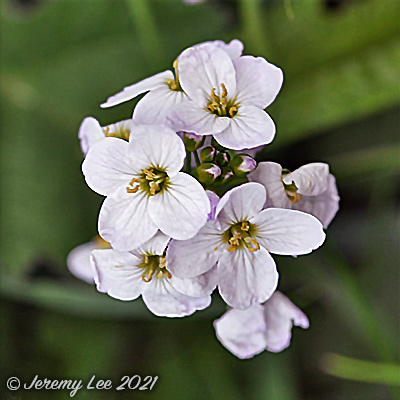
 |
|
Scientific Classifications explained » Amphibians » Ants » Aphids » Bees » Beetles » Birds » Bugs » Butterflies » Caterpillars » Damselflies » Dragonflies » Earwigs » Flies » Frog/Leafhoppers » Fungi » Galls » Grasshoppers » Harvestmen » Hoverflies » Lacewings » Ladybirds » Leaf Mines » Lichens » Mammals » Millipedes » Mosses » Moths » Sawflies » Slugs » Snails » Spiders » Trees & Shrubs » Wasps » Wild Flowers » Woodlice » Postboxes |
UK Nature > Wild Flowers > White Wild Flowers > Cardamine pratensis

Scientific Name: Cardamine pratensis Common Name: Cuckoo Flower Cardamine pratensis (commonly known as the Cuckoo Flower), like its namesake the cuckoo, comes in April; but May and June are the months when cuckoo flowers bloom in greatest profusion. It's a member of the family Brassicaceae, native throughout most of Europe and Western Asia. A herbaceous perennial plant growing to 40-60 cm tall, it has pinnate leaves 5-12 cm long with 3-15 leaflets, each leaflet about 1 cm long. The flowers are produced on a spike 10-30 cm long, each flower 1-2 cm diameter with four pale pink (sometimes white) petals. It is a food plant for the Orange Tip butterfly (Anthocharis cardamines) and makes a valuable addition to any garden which aims at attracting wildlife. The Common Froghopper (Philaenus spumarius) is attracted to the sap of these plants, and its larvae form frothy blobs on the stems (cuckoo spit). |
|

https://www.uknature.co.uk is a website dedicated to showing the immense diversity of UK nature and wildlife. Our vast range of habitats, from lowland arable to snow covered mountains, from storm-ravaged coastlines to peaceful inland freshwater lakes and rivers, from dry, sandy heaths to deciduous and coniferous forests, all these habitats contribute to the abundance of UK nature. We have wild birds in huge numbers either residing or visiting our shores (597 recorded species as at July 2013) and we must also not forget the humble back garden with its grass lawns, flower beds filled with nectar rich flowers, shrubs and trees, all designed to attract huge numbers of insects such as bees, moths, butterflies and hoverflies; and finally the small ponds which provide safe havens for frogs, toads, newts and even slow worms and grass snakes. www.uknature.co.uk is the showcase for my personal passion, photographing uknature in all its glory. I sincerely hope you all enjoy the fruits of my labours. This site and all images contained therein is © Jeremy Lee 2004 - 2025. All Rights Reserved. Site design by Jeremy Lee. Site development & IT Support by Stuart Lee. |